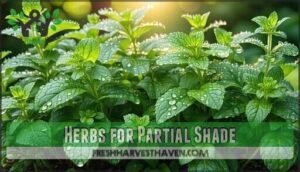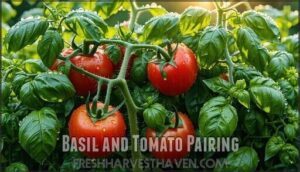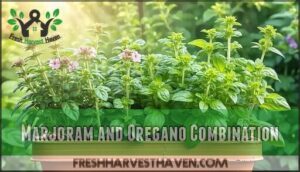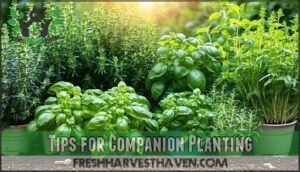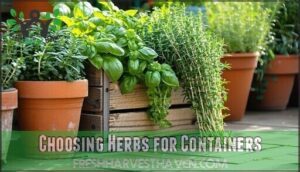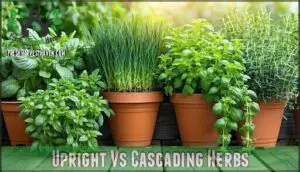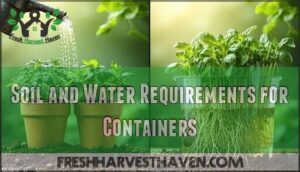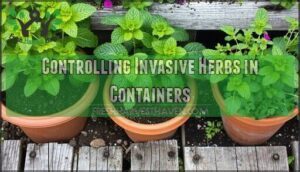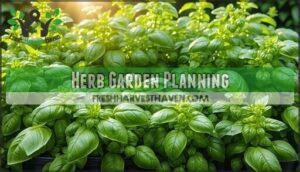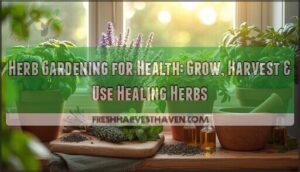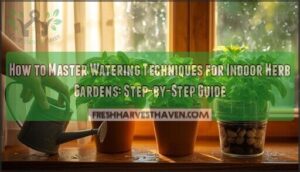This site is supported by our readers. We may earn a commission, at no cost to you, if you purchase through links.
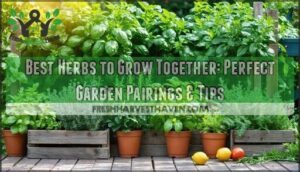
Mediterranean herbs like basil, rosemary, thyme, and oregano thrive in sunny spots with well-draining soil.
For shadier areas, pair mint with lemon balm or cilantro with chervil.
Container gardening works perfectly for controlling aggressive spreaders like mint while keeping slower-growing herbs like sage happy.
Group annual herbs like basil separate from perennials like lavender to simplify maintenance.
Consider companion benefits too – basil naturally repels pests from tomatoes, while borage attracts beneficial pollinators.
Smart pairings create healthier plants and bigger harvests with less work.
Table Of Contents
- Key Takeaways
- Herbs for Full Sun
- Herbs for Partial Shade
- Companion Herb Planting
- Container Herb Gardening
- Herb Garden Planning
- Frequently Asked Questions (FAQs)
- Which herbs mix well together?
- What is the best layout for an herb garden?
- What herbs go well in pots together?
- What herb is best to plant together?
- What herbs go well together?
- What is the best combination of herbs?
- Which herbs grow best together?
- What herbs can be used to increase blood flow to legs?
- What herbs grow well together in pots?
- What herbs are easy to grow?
- Conclusion
Key Takeaways
- Match herbs by growing needs – You’ll succeed when you pair Mediterranean herbs like basil, rosemary, and thyme together in sunny spots, while grouping shade-lovers like mint and cilantro in cooler areas with similar water requirements.
- Use containers to control aggressive spreaders – You can prevent invasive herbs like mint from taking over by growing them in individual pots or sinking containers into the ground, making maintenance easier while protecting other plants.
- Separate annuals from perennials – You’ll simplify garden care by grouping fast-growing annuals like basil separately from long-lived perennials like lavender, since they have different maintenance schedules and replacement needs.
- Choose companion plants for natural benefits – You’ll create healthier gardens by pairing herbs that help each other, like basil repelling pests from tomatoes or borage attracting pollinators to boost overall garden productivity.
Herbs for Full Sun
If you’re planning a full sun herb garden, you’ll want to choose herbs that can handle at least six hours of direct sunlight daily.
Popular full sun herbs like basil, rosemary, thyme, oregano, lavender, and sage but also tolerate intense sunlight and actually develop stronger flavors and healthier growth when given plenty of sun exposure.
Basil and Rosemary Combination
Basil and rosemary make excellent companion herbs despite their different watering needs.
These Mediterranean herbs create perfect garden partnerships when you understand their unique needs.
You can successfully grow these aromatic plants together by following these essential steps:
- Plant in separate containers – This prevents rosemary’s drought preference from conflicting with basil’s moisture needs
- Ensure proper drainage – Both herbs require well-draining soil to prevent root rot
- Position in full sun – These Mediterranean herbs thrive with 6+ hours of direct sunlight
These herbs also require different soil conditions, so it’s vital to keep in mind their well-draining soils.
Their combined aromatic benefits create natural pest repellents while offering diverse culinary uses and complementary flavor profiles.
Thyme and Oregano Pairing
Another winning pair for sunny spots, thyme and oregano share similar growth habits and thrive in well-drained soil with minimal water.
Their complementary flavor profiles enhance Mediterranean dishes perfectly.
| Aspect | Thyme | Oregano |
|---|---|---|
| Growth Pattern | Low, spreading mat | Upright, bushy clumps |
| Harvest Time | Year-round (perennial) | Peak summer flavor |
| Culinary Uses | Roasts, soups, marinades | Pizza, pasta, tomato dishes |
| Pest Deterrence | Repels cabbage worms | Deters ants, mosquitoes |
These best herbs to plant together create natural pest deterrence while simplifying garden design.
Summer herbs like these also benefit from regular pruning techniques to encourage bushier growth.
You’ll find their culinary herb combinations work beautifully in everything from grilled vegetables to herb-crusted meats, making them essential herb combinations for any sunny garden space.
Lavender and Sage Benefits
With lavender and sage, you get a classic example of Aromatic Synergy in your garden.
These two herbs thrive in full sun, love dry, well-drained soil, and excel in drought tolerance.
Together, they form one of the most beneficial herb combinations for companion planting.
Their strong scents work as natural Pest Repellents and attract pollinators, making your garden both beautiful and resilient.
You can also find lavender sage essential oil derived from these plants.
- Aromatic Synergy
- Pest Repellents
- Soil Preference: dry, well-drained
- Pollinator Attraction
Growing Conditions for Full Sun Herbs
For thriving full sun herbs, you’ll need at least six hours of direct sunlight duration each day.
Well-draining soil is essential—waterlogged roots spell disaster.
Mediterranean herbs like rosemary handle heat beautifully.
Keep watering needs moderate; overwatering kills faster than drought.
Skip heavy fertilizers—these nutrient requirements stay minimal.
When selecting herbs that grow well together, match their sun requirements and soil preferences.
Your heat tolerance champions include oregano and thyme, perfect companions for sunny spots.
Herbs for Partial Shade
Not all herbs need blazing sun to thrive in your garden.
Partial shade herbs like mint, lemon balm, and chervil actually prefer some relief from intense afternoon heat and can produce more tender, flavorful leaves when protected from harsh sunlight.
They can be more flavorful when given the right conditions.
Mint and Lemon Balm Combination
When growing mint and lemon balm together, you’ll discover companion planting herbs that thrive in partial shade.
Both species exhibit invasive tendencies, requiring growth control through containers. Their flavor profiles complement each other beautifully, while aromatic benefits naturally repel pests.
These herbs that grow well together offer excellent culinary uses.
Here’s why mint and lemon balm make perfect partners:
- Their shared love of partial shade creates ideal growing conditions
- Both herbs release calming scents that soothe your senses
- Container growing prevents these invasive herbs from taking over
- Their complementary flavors enhance teas, desserts, and savory dishes
Chervil and Cilantro Pairing
Many gardeners overlook how well chervil and cilantro work together in partial shade.
Their similar flavor profiles blend smoothly in dishes, offering unique culinary uses. Both attract helpful insects, boosting natural pest control.
For best results, place these herbs side by side in your companion herbs list. As they’re both leafy herbs, they adapt well to shade.
Here’s a quick guide:
| Herb | Flavor Profile | Growing Tips |
|---|---|---|
| Chervil | Mild, Anise | Moist, cool soil |
| Cilantro | Bright, Citrus | Well-drained, rich |
| Pairing | Balanced | Partial shade ideal |
| Benefits | Pest control | Easy combinations |
Angelica and Hyssop Benefits
These dynamic pairs create powerful medicinal properties that benefit your garden and health.
Angelica uses include supporting respiratory wellness and improving circulation through its warming compounds. Various hyssop varieties offer anti-inflammatory effects that soothe breathing issues while providing antiviral protection.
Growing angelica alongside companion herbs enhances garden biodiversity as both attract beneficial pollinators. This herb garden combination works well in partial shade, creating an effective companion herbs list for growing herbs together guide.
Their shared growing conditions make them perfect herbs for companion planting, establishing a thriving medicinal sanctuary.
Soil Requirements for Partial Shade Herbs
Part shade herbs flourish in well-draining soil that balances moisture retention with proper drainage needs.
These compatible herb plants require specific soil requirements to thrive in your herb garden combinations.
Essential soil requirements for part shade herbs:
- Soil pH between 6.0-7.5 for ideal nutrient absorption
- Organic matter like compost to boost nutrient levels naturally
- Drainage needs met without waterlogged conditions that damage roots
- Moisture retention capacity for consistent hydration without oversaturation
This growing herbs together guide guarantees your part shade herb garden combinations succeed with proper soil preparation.
Companion Herb Planting
You’ll discover that strategic herb pairings create stronger, healthier gardens while maximizing flavor and natural pest protection.
The right combinations work together to repel harmful insects, attract beneficial pollinators, and enhance each other’s growth through complementary root systems and nutrient needs.
Basil and Tomato Pairing
Why not pair these two garden favorites for maximum benefit? Basil and tomatoes create the perfect companion planting match in your herb garden combinations.
Basil provides pest repellency against aphids and tomato hornworms while offering flavor enhancement to nearby tomatoes.
These compatible herb plants share similar watering needs and provide mutual growth support.
Plant them together in sunny locations with proper spacing for ideal air circulation and thriving results.
Marjoram and Oregano Combination
When you plant marjoram and oregano together, you’ll discover their flavor profiles complement each other perfectly.
Marjoram brings sweet, floral notes while oregano adds earthy intensity. This culinary synergy enhances marinades and roasted dishes.
Both culinary herbs share similar growth habits, thriving in full sun with well-draining soil. Their aromatic impact naturally provides pest resistance, protecting your garden.
This companion planting strategy creates successful herb combinations that benefit both plants and your kitchen. They can be part of successful herb pairings if planted correctly.
Borage and Strawberry Benefits
While oregano and marjoram create aromatic harmony, borage brings remarkable benefits to your strawberry patch.
This blue-flowered herb acts as a natural pest repellent while attracting essential pollinators to boost fruit production.
- Yield boosting: Strawberries grown with borage produce substantially more fruit through enhanced pollinator attraction
- Flavor enhancement: Borage pulls beneficial micronutrients from soil, enriching strawberry taste naturally
- Growth support: Creates ideal growing conditions that strengthen strawberry plant development
- Pest repellent: Deters harmful insects while maintaining beneficial garden ecosystem balance
Tips for Companion Planting
Think of companion planting as matchmaking for your herb garden.
Use a companion planting chart herbs to pair varieties that share similar growing needs.
Focus on pest repellents like rosemary with basil, or attracting pollinators with dill and cilantro combinations.
Flavor enhancement occurs when oregano supports marjoram’s growth support.
Smart herb pairings create space optimization, turning plant combinations into successful herb combinations through strategic herb garden planning.
Container Herb Gardening
Container gardening lets you grow herbs in controlled spaces while pairing compatible plants for better growth and flavor.
You’ll need to match herbs with similar water and sunlight needs to create thriving mini-gardens that fit anywhere from patios to windowsills.
Choosing Herbs for Containers
Container size matters most when selecting herbs for pots. Choose containers at least 6-8 inches deep with proper drainage holes.
Well-draining potting soil prevents root rot. Group herbs with similar watering needs together – Mediterranean herbs like rosemary and thyme prefer drier conditions, while basil needs consistent moisture.
Creative herb container ideas include mixing textures and heights. Popular herbs to grow in pots together are basil with parsley, or sage with thyme for complementary growth patterns.
Exploring herb container solutions can provide further inspiration.
Upright Vs Cascading Herbs
How you arrange upright versus cascading herbs can make or break your container gardening success.
Growth habit matters—a tall rosemary or sage gives your herb garden structure, anchoring the back of a pot. Cascading types, like thyme or oregano, spill over the edges, boosting visual appeal and maximizing space needs.
Use the table below to guide your container choice and herb garden design ideas:
Pairing these herbs to grow in pots together balances beauty and easy maintenance, which is crucial for the success of your container gardening, and it is important to prune for shape and size, and to control for spreading growth, to achieve a well-structured herb garden with visual appeal.
Soil and Water Requirements for Containers
Your container herbs need the right foundation to flourish. Well-draining soil prevents root rot, while proper watering keeps plants healthy without drowning them.
- Drainage Importance: Choose pots with multiple drainage holes to prevent waterlogged roots
- Potting Mixes: Select quality potting mix with perlite or vermiculite for proper aeration
- Watering Frequency: Water when top inch feels dry, checking soil moisture regularly
Container gardening success depends on matching soil and water requirements to your herbs’ needs. Most herbs prefer slightly dry conditions over soggy soil. You can find the ideal soil mixes for container herbs.
Controlling Invasive Herbs in Containers
Three simple steps keep invasive herbs from overtaking your containers. Pot submerging works best—sink containers 12 inches deep, leaving rims exposed to block spreading root systems.
Individual pots isolate aggressive growers like mint and lemon balm completely. Root pruning every few months controls growth in established containers.
| Control Method | Best For | Maintenance |
|---|---|---|
| Pot Submerging | Mint, Lemon Balm | Check rim monthly |
| Individual Containers | All Invasive Herbs | Trim weekly |
| Root Pruning | Established Plants | Every 3 months |
| Container Barriers | Multiple Herbs | Monitor growth |
| Drainage Holes | Potting Mix Health | Clean seasonally |
Herb Garden Planning
Planning your herb garden starts with understanding which plants share similar needs and won’t compete with each other.
You’ll want to group herbs by their water, light, and soil requirements while keeping aggressive growers contained to prevent them from taking over your entire garden, considering their complete concepts of growth.
Grouping Herbs by Growth Requirements
Successful herb gardening starts with matching plants by their growth habits.
Group Sun vs. Shade lovers separately—basil and oregano need six hours of direct light, while mint prefers partial shade.
Match Watering Needs by pairing thirsty herbs like parsley with moisture-loving companions.
Consider Soil Composition and Climate Considerations when grouping Herb Hardiness zones together for desirable results.
Identifying Annual and Perennial Herbs
A gardener’s wisdom starts with Identifying Herbs by their lifecycles. Annual herbs, like basil, live fast—blooming and seeding in one season. Perennial herbs, such as rosemary and thyme, offer a Perennial Comeback, returning year after year if the climate allows.
Biennial herbs, like parsley, give you that Biennial Flavor, peaking in their second year. Understanding Herb Hardiness and Annual Lifecycles helps you plan, save seeds, and choose what suits your zone.
To guarantee a continuous supply, consider a seasonal herb calendar. Here’s a quick guide:
- Annual herbs: basil, dill, cilantro
- Perennial herbs: rosemary, thyme, lavender
- Biennial: parsley
- Propagation: seeds, cuttings
- Climate matters
Controlling Aggressive Herb Growers
Some herbs spread like wildfire through underground runners and aggressive root systems. Herb containment starts with potting methods – sink containers into soil with rims above ground to create root barriers.
Install deep metal edging around problem plants. Trimming techniques include removing flower heads before seeding and cutting runners weekly.
Growth monitoring helps catch escaped shoots early. For enhanced control, consider using specialized physical barriers designed for this purpose.
These allelopathic chemicals from invasive herbs can cause stunted growth in nearby plants, making compact growth management essential for unhealthy plants recovery.
Tips for a Thriving and Diverse Herb Garden
Build solid planning through healthy soil and smart watering techniques.
Regular harvesting methods encourage growth while pest prevention protects your herb garden naturally.
Design your garden layout grouping compatible garden companions together.
Choose fragrant herb pairings that support each other’s development.
Focus on flavor improvement by matching herbs with similar needs.
Your herb garden design should balance sun-loving and shade-tolerant varieties for year-round success.
Frequently Asked Questions (FAQs)
Which herbs mix well together?
You’ll find success pairing rosemary with thyme, basil with parsley, and oregano with marjoram. These combinations share similar growing needs while enhancing each other’s flavors and naturally repelling garden pests.
What is the best layout for an herb garden?
Start by grouping sun-loving herbs like rosemary, thyme, and oregano together, then place shade-tolerant varieties like parsley and chives nearby.
Create defined sections to prevent invasive mint from spreading throughout your garden space, which helps to maintain a well-organized and separate garden layout.
What herbs go well in pots together?
You’ll find success pairing rosemary, thyme, and sage in containers since they share similar water and sunlight needs.
Basil, Italian parsley, and chives also thrive together, creating flavorful combinations for your cooking adventures.
What herb is best to plant together?
Picture two herbs whispering secrets in morning dew—that’s rosemary and thyme together.
You’ll find they’re perfect companions, sharing drought tolerance while repelling pests and enhancing each other’s aromatic oils naturally.
What herbs go well together?
You’ll find success pairing herbs with similar needs: rosemary and thyme thrive together, while basil and parsley complement each other perfectly, creating beneficial growing partnerships.
What is the best combination of herbs?
Absolutely amazing combinations create garden magic.
You’ll love growing rosemary and thyme together—they’re drought-tolerant powerhouses that repel pests while enhancing each other’s flavors.
Add basil and oregano for incredible culinary versatility.
Which herbs grow best together?
You’ll find great success pairing rosemary with thyme, basil with oregano, or sage with lavender.
These combinations share similar water and sunlight needs while creating natural pest barriers and enhancing each other’s flavors in your garden, which also creates a great opportunity for complete concepts to flourish.
What herbs can be used to increase blood flow to legs?
Back in the days of knights and round tables, folks turned to herbs like ginger, ginkgo biloba, cayenne, and garlic.
You can use these to support blood flow to your legs, thanks to their circulation-boosting properties.
What herbs grow well together in pots?
You’ll find great success combining basil, Italian parsley, and chives in one container, or try rosemary, thyme, and sage together.
These herbs share similar sunlight and water needs, making container care straightforward while providing fantastic flavors for your cooking adventures.
What herbs are easy to grow?
Incredibly forgiving herbs practically grow themselves.
You’ll discover that chives, basil, and cilantro are wonderfully low-maintenance options.
These resilient plants forgive beginner mistakes while providing continuous harvests throughout the growing season, making them incredibly forgiving.
Conclusion
Successfully pairing the best herbs to grow together transforms your garden from ordinary to extraordinary.
You’ll discover that matching herbs by their sun, water, and soil preferences creates thriving plant communities that practically grow themselves.
Mediterranean herbs flourish together in sunny spots, while shade-loving varieties form perfect partnerships in cooler areas.
Container gardening lets you control aggressive spreaders while maximizing space, allowing for abundant harvests and promoting healthier plants throughout the growing season.
- https://www.bhg.com/gardening/vegetable/herbs/best-herbs-to-plant-together/
- https://www.rainbird.com/homeowners/blog/the-benefits-of-companion-planting
- https://earthsally.com/gardening-basics/natural-pest-control-herbs-to-keep-bugs-away.html
- https://www.gardenary.com/blog/can-you-grow-all-your-herbs-together-in-one-pot-or-container
- https://www.reddit.com/r/containergardening/comments/111gwac/growing_multiple_herbs_in_the_same_container/

